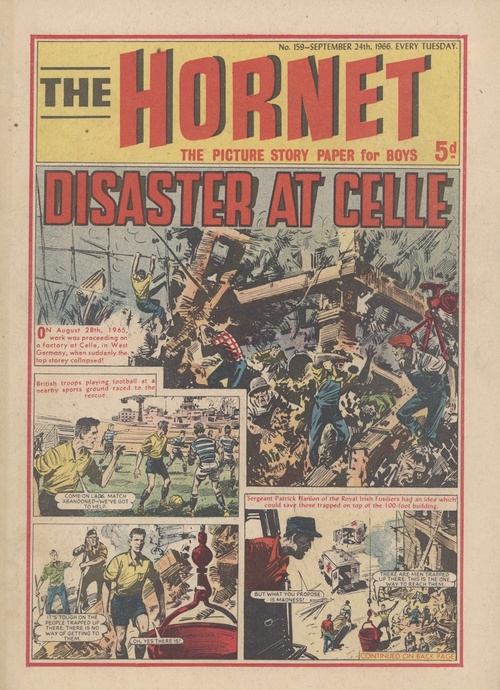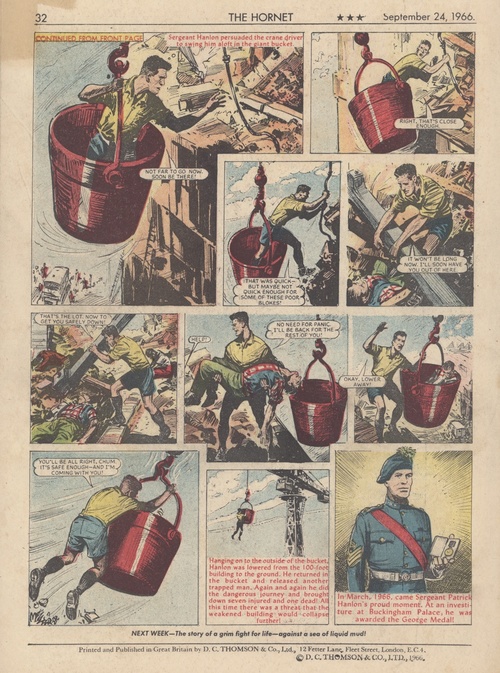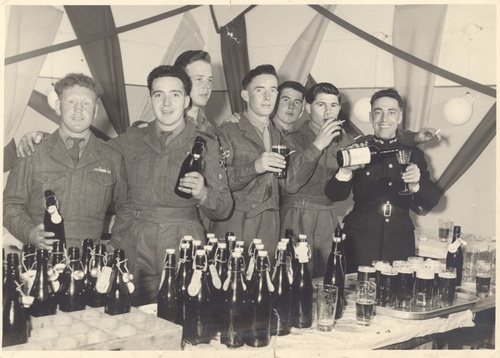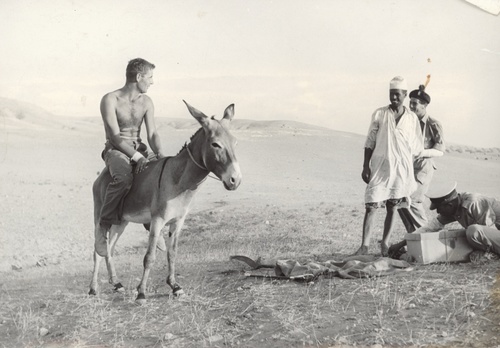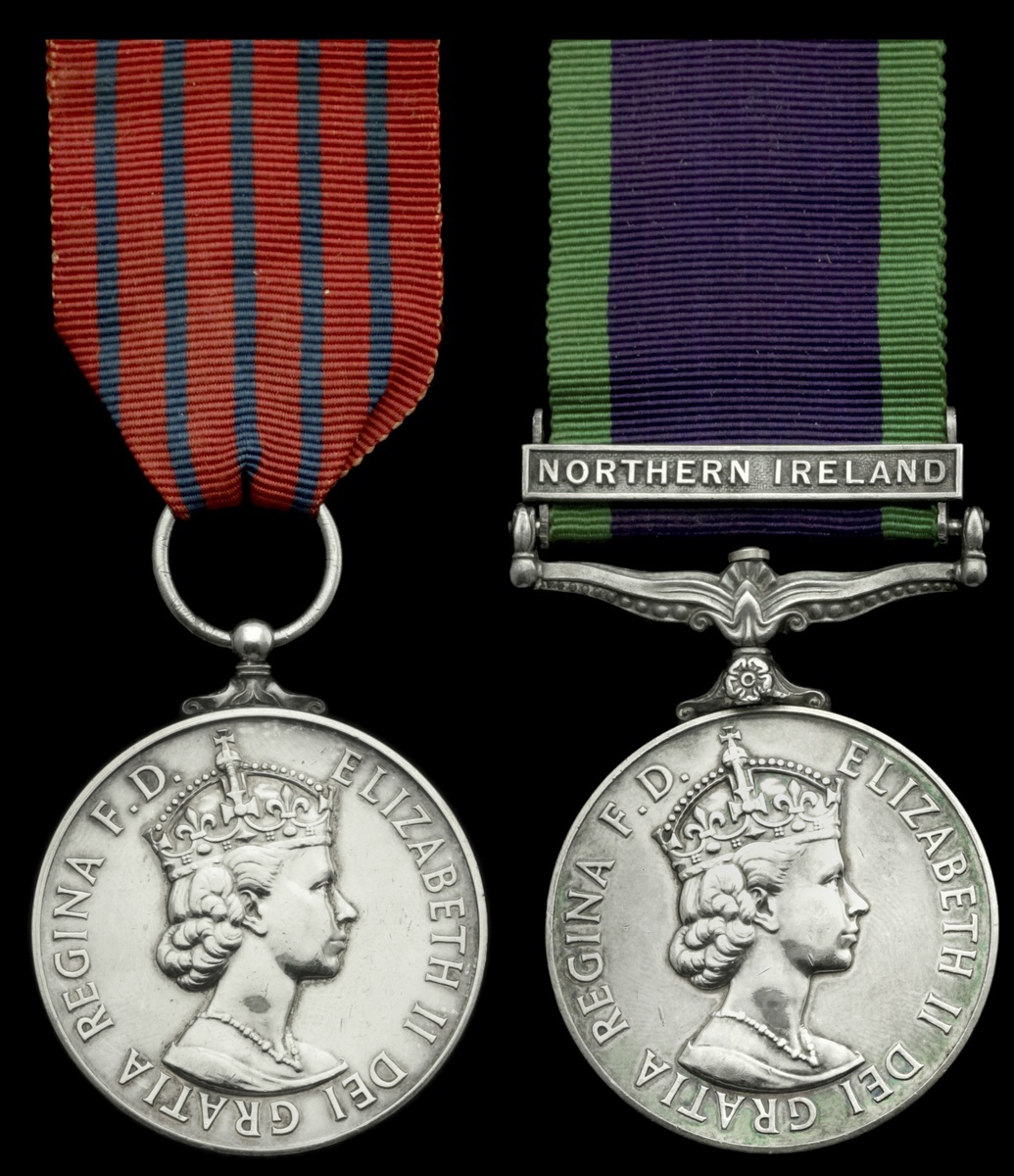Auction: 20002 - Orders, Decorations, Medals & Space Exploration
Lot: 577
(x) 'My kid brother sounded excited. Laurence was telephoning me at Bourlon Camp, Catterick, from the family's home in Small Heath, Birmingham.
"What's all this about you being a hero?" asked Larry.
"What do you mean?" I replied.
"You've got the George Medal for rescuing those workers in Germany last August. It was in the 'London Gazette' today," said Larry.
When I'd thanked my brother for the wonderful news, I rang off. As I did so, memories of the rescue incident came flooding back.'
Sergeant Hanlon is informed by his younger brother that he is to be awarded the George Medal, as published in The Weekly News, 7 May 1966.
The remarkable 1965 G.M. pair awarded to Colour-Sergeant P. Hanlon, Royal Irish Fusiliers, decorated for repeated gallantry after the collapse of a construction site which tumbled inwards 'like a pack of cards'
Hearing those trapped high up, Hanlon jumped into a cement bucket and was hoisted 100ft in order to reach the injured - he repeatedly hauled survivors into the bucket, whilst himself clinging to the exterior on the way down; his exploits resulted in coverage on the front and back covers of The Hornet
George Medal, E.II.R. (23237829 Sgt. Patrick Hanlon, R. Ir. F.); General Service 1962-2007, 1 clasp, Northern Ireland (23237829 S.Sgt. P. Hanlon G.M. R. Irish), together with corresponding miniature awards, nearly extremely fine (4)
G.M. London Gazette 11 January 1966. The official citation states:
'On the morning of Saturday the 28th of August 1965, Sergeant Hanlon was playing in a soccer game on the Battalion Sports Field which is situated approximately half a mile away from Trenchard Barracks in Celle.
Adjacent to the Sports Field there was a German civilian biscuit factory under construction. At 1140 hours that morning the top storey of this building collapsed whilst civilians were still at work in the building.
The sound of the tremendous crash stopped the football match and both teams ran towards the building to give help.
On arrival at the site it was discovered that the German officer workers and men on the ground were so shocked that no rescue action was being taken. Two parties, each under an officer, started to clear debris and free men at ground level. Meanwhile Sergeant Hanlon realised that there were several men trapped at the top of the building amongst the demolished masonry, sought out the crane driver and encouraged him to operate his crane.
Sergeant Hanlon emptied the crane bucket of its load of cement, climbed into the bucket and directed it to the top of the demolished part of the building. This involved a lift of about 100 ft. off the ground. He then got out of the bucket and set about searching for and releasing the injured civilians who were trapped in the debris. While he was doing this there was the continuous threat of a further collapse of the building. During the course of approximately ten trips he returned with seven injured or shocked civilians whom he had rescued, and one dead. On each occasion he placed the injured man in the bucket itself while he returned holding on to the outside. On some occasions he was assisted by an Italian Works Foreman who helped him to release those that were trapped.
Independent of any other rescue work, the part played by Sergeant Hanlon was directly instrumental in preventing further loss of life, either through delay in assistance to the injured or as a consequence of panic amongst those who were stranded or trapped.
He was indifferent to the height he had to travel up and down in the crane and ignored personal risk from a further collapse of the building.
By his presence of mind, prompt action and disregard for his own safety, Sergeant Hanlon not only saved life, but by his very act of rescue eased the tension and reduced the atmosphere of shock. He set an example which encouraged further rescue operations to proceed without delay.
On the arrival of the German Fire Brigade and Civil Defence units the soldiers on the ground were asked to move clear of the area, but no attempt was made to relieve Sergeant Hanlon of his work.'
Patrick Hanlon was born around 1936 at Dublin, the son of Anna Hanlon and stepson of Thomas Batterton, of Langley Grove, Small Heath, Birmingham. He moved with his mother from Ireland to Birmingham around 1950, and attested for the 1st Battalion, Royal Irish Fusiliers upon leaving school, likely on his eighteenth birthday (The Belfast Telegraph, refers). As a young man he served in Aden, Cyprus and Swaziland - at the latter, being part of the Francistown Radio Station Garrison. Transferred to the German town of Celle in the mid-1960s, he suddenly found himself in the midst of a 'pretty chaotic' situation (The Birmingham Post, refers), whilst acting as a referee during a soccer match between Charlie company and Delta company of his regiment. At ten minutes past twelve on an otherwise uneventful spring day, there was suddenly a terrific crashing noise nearby. With the score standing at 5-3 in favour of Hanlon's own company:
'All the players suddenly stopped running as if turned to stone' (The Weekly News, refers).
As the men watched, they could see the top floor of a building under construction caving in upon itself, walls crumbling, girders collapsing and bodies of the workmen falling everywhere. For a couple of seconds no one moved, indeed it took a moment for the sight to sink in. Then pandemonium broke loose. The events which followed are best described by the recipient himself, published in The Weekly News on 7 May 1966:
'I blew my whistle and shouted at the lads to follow me… All 23 of us set off towards the building with a handful of spectators bringing up the rear. It was like a cavalry charge as we sprinted across the field, and jumped and scrambled over an eight-foot wire mesh fence. The top story of the building, which I learned later was a new Swedish biscuit factory, had caved inwards. It looked as if the rest might come down at any second.
First, I sent one of my lads off to our camp for the M.O., and gave orders for the fire brigade, ambulances and police to be summoned. It would be some minutes before they arrived, and meanwhile I could hear people who were trapped in the debris moaning… I looked for a ladder but couldn't see one.'
Spotting a crane, he informed the German operator in no uncertain terms that he required his help to bring down some of the injured. Realising that the pair could not achieve this alone, he asked an Italian builder to assist:
'He was terrified of going, and said he was a carpenter, not a scaffolder… I had no time to argue with him. I virtually pushed him into the bucket, which was too small to allow both of us to crouch down inside. So as the crane began to hoist us to the top of the building, the Italian crouched inside while I stood on the outer rim. We came alongside the man who had been pinned down by a thick wooden prop and electricity cables. He was unconscious, but I managed to feel a pulse.'
Shouting down for the current to be switch off, Hanlon set about cutting through the cables with his penknife. After ten minutes he managed to pull the beam away, and, helped by the Italian - who assisted in steadying Hanlon - the two men eased the casualty into the bucket. The trio were then lowered to the ground where they were met by friendly faces equipped with a stretcher.
Repeated Courage
Seeing more people trapped inside the rubble, Hanlon made the dicey decision to signal the crane driver to lower him directly into the debris from above the building. Now acting alone, he entered an environment of collapsed floors and continually crumbling masonry:
'The moans of the crippled workers drove me on.'
One had a bad chest injury. There was blood everywhere, but he was still breathing. Another two bodies nearby were lifeless. Making the heart breaking decision to leave the latter until last - believing there was nothing he could do for them - Hanlon hauled the injured man into the bucket and indicated to the crane driver to bring them to safety. Returning to the scene again, he discovered a man pinned by a water tank who was quite incredibly still alive:
'The Italian and myself heaved the tank onto the bucket and I instructed the driver to move it away from the spot.'
Such ingenuity gave the man at least a chance of survival.
Altogether, Hanlon made around a dozen trips during a rescue which lasted over one and a half hours. Exhausted, the sweat 'poured off' him at its conclusion, his tracksuit looking much the worse for wear. The disaster resulted in four persons losing their lives and twelve injured.
Invited for an investiture at Buckingham Palace later that year, he was presented his richly-deserved G.M. by The Queen. No doubt proud of his award, he chose to remain very much the 'quiet hero' (The Birmingham Post, refers). The third 'Faugh' to win the George Medal after Colonel Brian Clark and Lieutenant-Colonel Baxter, he largely kept his gallantry under wraps - with the exception of his wedding day when proudly wearing his award upon his chest. Conducted at St. John's Roman Catholic Church in Tamworth, the bride - Miss Susan Griffin - positively beamed as she held the arm of her new husband, resplendent herself in a full-length cream gown of wild silk.
His exploits were immortalised by The Hornet comic which devoted its September 1966 edition - front and back covers - to the 'Disaster at Celle'. Hanlon remained in the Army for a number of years after the incident, becoming a highly-skilled radio operator. He died around 1996 in consequence of a brain tumour (The Daily Mail, refers), leaving behind a daughter, Rachel:
'I'm so proud of him - it's a fabulous story and he was a real hero!'
Sold together with three original copies of The Hornet picture story paper for boys, September 1966 Edition, one a little tatty and faded; original and copied newspaper articles, with 16 portrait and group photographs of the recipient - including images from his military career and some delightful photographs from his wedding day.
Subject to 5% tax on Hammer Price in addition to 20% VAT on Buyer’s Premium.
Estimate
£7,000 to £9,000
Starting price
£7000



